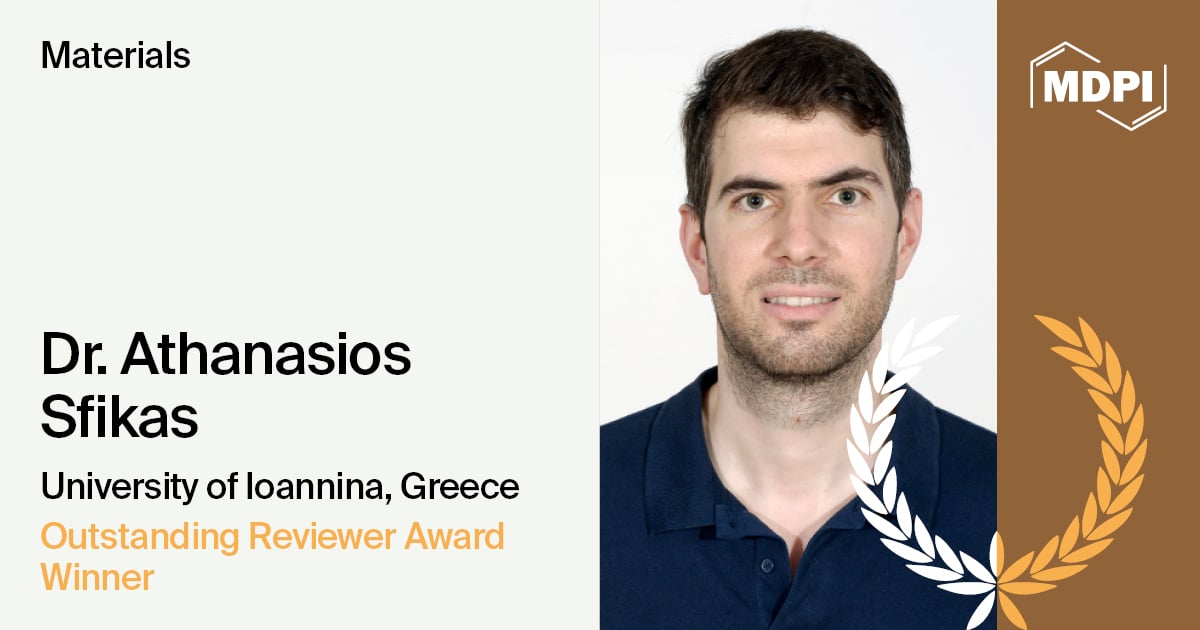5 March 2025
Interview with Dr. Athanasios Sfikas—Winner of the Materials 2024 Outstanding Reviewer Award

You are accessing a machine-readable page. In order to be human-readable, please install an RSS reader.
All articles published by MDPI are made immediately available worldwide under an open access license. No special permission is required to reuse all or part of the article published by MDPI, including figures and tables. For articles published under an open access Creative Common CC BY license, any part of the article may be reused without permission provided that the original article is clearly cited. For more information, please refer to https://www.mdpi.com/openaccess.
Feature papers represent the most advanced research with significant potential for high impact in the field. A Feature Paper should be a substantial original Article that involves several techniques or approaches, provides an outlook for future research directions and describes possible research applications.
Feature papers are submitted upon individual invitation or recommendation by the scientific editors and must receive positive feedback from the reviewers.
Editor’s Choice articles are based on recommendations by the scientific editors of MDPI journals from around the world. Editors select a small number of articles recently published in the journal that they believe will be particularly interesting to readers, or important in the respective research area. The aim is to provide a snapshot of some of the most exciting work published in the various research areas of the journal.
Original Submission Date Received: .

The Outstanding Reviewer Award is presented annually to recognize individuals who generously dedicate their time to reviewing papers while demonstrating thoroughness, professionalism, and timeliness.
We are thrilled to share the following interview with one of the winners of the Materials 2024 Outstanding Reviewer Award, Dr. Athanasios Sfikas. In the field of academic publishing, reviewers play a pivotal role as the “gatekeepers” of scholarly quality. Through their expertise and rigorous approach, they meticulously examine each submitted academic paper, ensuring that it meets the highest standards of research and academic quality.
Below is a short interview with Dr. Athanasios Sfikas:
1. Could you introduce yourself to our readers? What is your current research area?
My name is Athanasios Sfikas, and I am a materials engineer specializing in metallurgy. My Ph.D. project focused on developing and studying the microstructure and properties of novel Al-Co alloys. During my postdoctoral research, I shifted my focus to the promising field of high entropy alloys. Currently, I work in industry but remain actively involved in research, writing, and reviewing papers in my free time. My focus is on aluminum alloys, metal matrix composites, high entropy alloys, and materials degradation.
2. What factors motivate you to be a reviewer for Materials?
Materials is a well-established journal in the field of materials science. I enjoy reviewing papers submitted to Materials because it gives me the opportunity to assess high-quality works. The journal features a wide variety of papers, covering both novel, promising materials and well-established ones.
3. Based on your rich reviewing experience, could you please share the common problems that authors face?
Many authors struggle to clearly and consistently explain the novelty of their work. Common issues include a brief experimental procedure section lacking a step-by-step analysis of materials fabrication and characterization. The results section should provide a deep analysis of the figures, formulation of mechanisms, and comparison to existing literature. Unfortunately, in several works, results consist of only brief comments on the figures without further analysis. Several research works also suffer from poor-quality figures and low-quality microscopy images.
4. Which research topics do you think will be of particular interest to the research community in the coming years?
The research community in the field of metallic materials will continue to focus on high-entropy alloys, additive manufacturing, and the continuous improvement of well-established alloys. Novel materials characterization and testing techniques will enhance our understanding of the underlying mechanisms at smaller dimensions.
